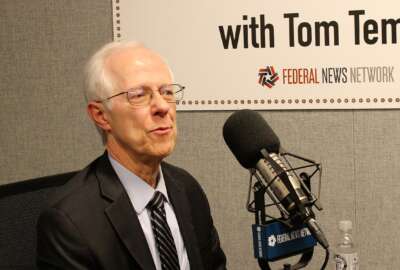

It’s been decades since the last time the Defense Department took an in-depth look at how its contract policies affect the financial health the defense indust...
It’s been decades since the last time the Defense Department took an in-depth look at how its contract policies affect the financial health the defense industrial base. That long-awaited report is now out. Meanwhile, a separate, outside study is examining what DoD needs to do to speed up its adoption of innovative technologies. To take a deeper look at both of those studies, the Federal Drive with Tom Temin talked with Stephanie Kostro, executive vice president for Policy at the Professional Services Council.
Interview transcript:
Jared Serbu All right, Stephanie we have a couple interesting reports to talk about this week, both dealing with various aspects of the defense acquisition system and DoD’s planning cycles. Let’s start with this new one last week from the Atlantic Council’s Commission on Defense Innovation. I guess, one of my takeaways, there was a lot of what they had to say kind of dovetails with the same topics that we’re seeing from the folks who are examining [Programming, Budgeting, and Execution (PPBE)] reform, things like consolidating program elements and dealing with reprograming authorities and streamlining the whole budgeting system. So, I mean, I guess it’s encouraging that there’s some consensus developing out there on what needs to be done. But what were some of your takeaways from their interim report?
Stephanie Kostro Sure. Thanks, Jared, and thanks for for raising this. The the Atlantic Council has this commission, and it’s the Commission on Defense Innovation Adoption. And what they’ve identified as their mission is to accelerate duties ability to adopt cutting edge tech, and then to deliver high impact operational solutions to the warfighter. This is an interim report. It’s got ten main recommendations. Some of them are of high interest to industry. And what’s interesting about this commission is that it’s a mix of former government officials, as well as current industry officials. And so there is a flavor you’ll see throughout this interim report of practicality, which flashed a bang in terms of requirements to fielding innovation has been a much admired subject over the last, however long, two decades. But this is the first report where I really seen them talk about how do you then adopt innovation. And so, my takeaways really, and some of the recommendations that were particularly interested in would be, strengthening the alignment of capital markets to the outcomes that you want to achieve. And so there’s a lot of talk about venture capital, etc. in the report. There’s also two other areas where, I’m talking to PSC members, they’re very interested. One is establishing a bridge fund to successfully move demonstrator technology into the field, which is that valley of death, oftentimes we talk about, this is a bridge fund for that. And then the other one of high interest to us, is how to modernize the requirement system. If you know from experience the [Joint Capabilities Integration and Development System (JCIDS)] process at DoD, it is arcane, it is constantly refreshed and added to. There’s nothing streamlined about it. And so those are the ones that we’re looking at with a high interest.
Jared Serbu And very top down. I think one of the things that the council was focused on here, where the commission was focused on here, was coming up with things that are implementable relatively soon. How would you say they did on that, in terms of coming up with recommendations that Congress and DoD can take and run with in the near term?
Stephanie Kostro Yeah. So the timing of this interim report was no accident. It’s mid-April. It’s the time where you send legislative proposals over for House and Senate Armed Services Committees for the appropriators to look at. So, in terms of what Congress can do, there is a lot for them to take away from this report. Whether or not they choose to do it is another question. What I’m looking forward to is this final report from the commission that’s coming out in September, and I hope they do reach out to PSC, other associations or member companies to really come up with case studies that support and lend evidence to what they’re trying to do here. Because I think a lot of times it’s a short report, it’s only 20 pages, it’s got ten recommendations. But you’ve got to have support for it, evidence, data, etc.. And I think that’s what they’re going to spend their time on. And that’s what I’m looking forward to.
Jared Serbu By contrast, the other study we want to talk about today is not 20 pages, it’s nearly 900. When you combine all the academic study and [Federally Funded Research and Development Centers (FFRDC)] study that went into the DoD contract finance study. First time since, I think 1985, the department has taken a deep dive on this particular issue. How they do?
Stephanie Kostro So we have been watching this contract finance study since it was mentioned in 2019. There was a [Government Accountability Office (GAO)] report that recommended that they undertake the study. Because you’re right, the last time there was a comprehensive look at contract finance at DoD, it was 1985. And a lot has changed in 30 years. And so, we looked at it, to be honest. I think it’s a bit narrowly focused. It’s not sort of the areas where we at PSC would have emphasized that they look at. And it’s the changing dynamics of the business environment. When you look at industry consolidation and where companies can find investment, that landscape has changed and I’m not sure that the report gets at that piece of it. I hope we can have follow on discussions about this contract finance report. We’re actually here, PSC is having its annual conference at the historic Greenbrier in White Sulfur Springs, West Virginia. And we have some folks from DoD who will be here, and I hope to catch them on the margins and have a little discussion about where we go from here.
Jared Serbu A lot of focus in the report on the need to kind of expose and gather more data on and do better management of the lower tiers of the supply chain within DoD. The flavor I got from the report, is duty has very good understanding of its direct suppliers, its prime contractors, and they are financially pretty healthy. And there’s just a lot less that is known or understood about those lower tiers.
Stephanie Kostro Yeah, we’ve been talking a lot with DoD about supply chain, Illumination is the phrase that they used to use, and sort of unpacking what the supply chain looks like. Without privity of contract, DoD really doesn’t have the ability to go into the sub tiers and sort of look into what they’re contributing within the final outcome or the final capability that’s fielded. So I do think, we have some efforts underway. Defense Logistics Agency is doing something right now to really unpack supply chains. It’s going to be a while before we have sufficient data I think that we can act on. But that isn’t to say we shouldn’t keep going, because I think supply chain illumination to make sure that progress payments, for example, that are going to primes flow down to the subs, particularly the small businesses who depend on these contracts. And so, I think you’re right, there is a lot to be done in supply chain. And this is just hints at it, but I think we really need to get a broader and more deep effort underway.
Jared Serbu The report to me came across as a little bit dismissive of industry’s concerns about budget instability in the financial impact that working with the government can have on some companies. The overall conclusion they seem to come to is, Hey, you guys are making money, everything’s fine, stop complaining. I’m being a little bit flip with that. But I mean, do they have a point when they point to the general overall good health of those prime contractors?
Stephanie Kostro So I come at it from a slightly different perspective. I come at it from, I think this report spends a lot of time talking about manufacturers and the products domain. We’re professional services contractors, so we look at the services perspective, and I would encourage DoD to look more holistically at the defense industrial base. There are companies that are doing quite well. But I think, one thing when you look at studying contract finance, it is about the primes, but it’s also about the subs and what’s flowing, what arrangements are teaming, arrangements are allowable, etc.. And this is something both my boss David Berteau, CEO president of PSC, and that I have often said, which is we don’t really reward small businesses for doing well or for going over time, because they have these small business set asides. But once they graduate, some of them hate that phrase. Once they graduate outside of their small status, they sort of fall into this abyss in many cases. And so, I think if I were queen for a day and wanted to redo the contract finance study, I would take a stronger look at the defense industrial base across the board with manufacturers and service providers. But I would also look at what incentives are we creating to make sure that small businesses want to enter this market, have the forecasting demand that makes them viable and want them to be part of this this industrial base. But then also, how to reward them for growth? How do we encourage them beyond just staying small?
Jared Serbu And I guess, back to one of your original points. It would be good if we didn’t wait another 30 years to do the next study. What’s the best way to make sure that this continues to be a topic of at least conversation and research and study and reform?
Stephanie Kostro Yeah, I think there’s openness to that. If you go back to the 2019 GAO report, it wasn’t just to assess DoD’s policies about defense industry, but refresh it periodically. Now, I don’t think I’d have to go look at the report again. I don’t think it said how often that periodicity should be. But I think there’s openness at the department to go, All right, so now we’ve done this big contract finance report, let’s go ahead and pull some of the threads. And I think that’s where associations like PSC can really provide data, anecdotes, information that maybe weren’t addressed in this report, all 900 pages of it.
Copyright © 2024 Federal News Network. All rights reserved. This website is not intended for users located within the European Economic Area.
Tom Temin is host of the Federal Drive and has been providing insight on federal technology and management issues for more than 30 years.
Follow @tteminWFED


